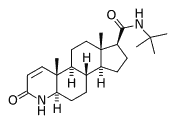Finasteride
Finasteride is an antiandrogen which acts by inhibiting 5-alpha reductase, the enzyme that converts testosterone to dihydrotestosterone. It is used in benign prostatic hyperplasia (BPH) in low doses, and in prostate cancer in higher doses. Additionally, it is registered in many countries for male-pattern baldness. Drug trade names include Propecia® and Proscar ® both products of Merck & Co. (the former is marketed for hair loss in male pattern baldness, and the latter for BPH). more...
The Prostate Cancer Prevention Trial (PCPT) showed at a dosage of 5mg per day, as is commonly prescribed for BPH, though much higher than the 1mg generally prescribed for hair loss, participants taking finasteride were 25% less likely to have developed prostate cancer at the end of the trial compared to those taking a placebo. However, the cancers that developed in the men taking finasteride looked like they were more likely to grow and spread. The reason for this is not known. The study researchers are continuing to watch these men to see if these cancers truly are more aggressive. At lower doses, this effect is less well-defined.
Recognised side-effects, experienced by around 4% of users, include erectile dysfunction, and less often gynecomastia (breast gland enlargement). In trial studies, side effects ceased after dosage was discontinued.
Side effects
Finasteride is not indicated for use by women. Do not take or handle this medication if you are pregnant or could become pregnant during treatment. Finasteride is in the FDA pregnancy category X. This means that it is known to cause birth defects in an unborn baby. Women who are or who may become pregnant must not handle crushed or broken Finasteride tablets. The medication could be absorbed through the skin. Propecia is known to cause birth defects in a developing male baby. Exposure to whole tablets should be avoided whenever possible, however exposure to whole tablets is not expected to be harmful as long as the tablets are not swallowed. It is not known whether Finasteride passes into breast milk. Finasteride is not intended for use by women and this medication should not be taken if you are breast-feeding a baby. It appears that Finasteride does pass into the semen of men, thus caution should be used to avoid ingestion of semen during oral sex if a woman is pregnant or may become pregnant.
Finasteride can also be used to mask steroid abuse, and many professional sports have banned finasteride use for this reason.
Read more at Wikipedia.org



